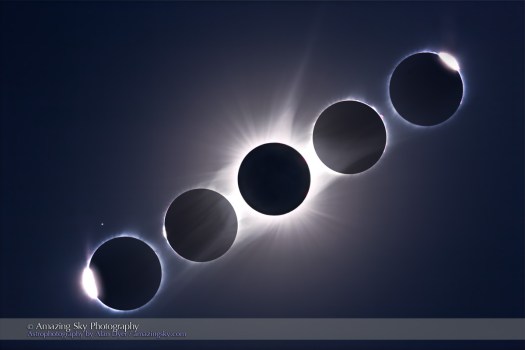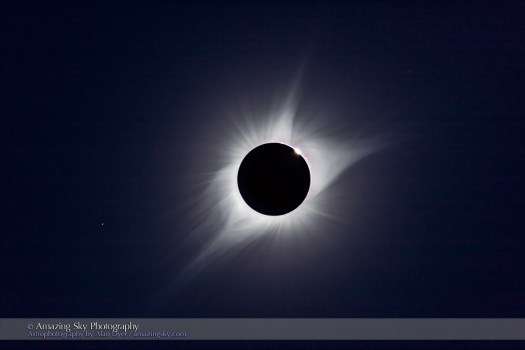
What a day! What a sky! What an eclipse!
Thank you Idaho for providing the finest sky we could have hoped for on eclipse day.
After several days of predictions that went from good, to bad, to not so good, prompting worries about having to escape west to clearer skies, August 21 turned out to be wonderfully clear, both cloudless and smoke free.
My site was the one I had planned from a scouting trip in April 2015, off the West 5000 Road north of Driggs, Idaho. It had a sightline to the Tetons, a great horizon, and I could drive to it with my carload of gear, a rare opportunity.
I had never driven to any total solar eclipse before, allowing me to shoot with all the telescope and camera gear I could muster and handle. And I had the site almost all to myself, a first for any total solar eclipse.

This was only the fourth eclipse out of the 16 I have been to that I shot though a telescope.
The lead image is a composite of second and third contact images with a blended exposure composite of totality, taken with the telescope shown here. However, this was the first time I’ve shot a total solar eclipse with an equatorial mount that was accurately polar aligned (at 5 a.m. that morning!) and tracking the Sun.

This is a composite of a long exposure of totality with a short exposure of the third contact diamond ring just beginning to break out from behind the dark disk of the Moon, just before it overpowered the red prominences that lined the edge of the Sun that day. making for an amazing sight through binoculars or telescopes.

No single exposure can capture the huge range in brightness in the corona.
The image above is a blend of seven exposures, from 1/1000 second to 0.4 seconds, creating a view that better resembles what the eye saw – with the exception of the faint Earthshine on the Moon. It is so faint, I don’t think it is visible to the eye, but the camera picks it up.
Regulus is the star at left, with several other fainter stars in Leo also visible.

While I had a telescope at the ready inches from my eyes for just visual looks, as it so often is, the naked eye scene was so compelling I forgot to look through the telescope until the last few seconds of totality.
The scene above captures the wide view, of the eclipsed Sun over the Grand Tetons, as seen from the Idaho side. The dark blue at right is the shadow of the Moon.
I shot the wide scene with two cameras and wide-angle lenses for time-lapse sequences. I’ve compiled them into a short video here.
Moonshadows: Eclipse Sky Time-Lapses from Alan Dyer on Vimeo.A more extensive music video is in the works.
For tips and techniques on how to process eclipse images, see my eBook on How to Photograph the Solar Eclipse. While most of the content is now past history, the chapter on processing images is more valuable than ever. The eBook is now just $2.99, on Apple, as a PDF, and on Amazon. Sorry for the shameless plug!
Thanks! It can now be cloudy for the next few months. It was clear when it needed to be!
— Alan, August 31, 2017 / © 2017 Alan Dyer / AmazingSky.com


WOW!!! What an amazing eclipse. These photos are excellent.
Have been looking forward to seeing your blog post with photos, since I wasn’t able to head south to view this in person. Thanks so much for sharing!
Great images, It was a great event. I am still processing the images I got in Oregon. Thanks for your advice in your blog, it helped a lot. Now to get to the next one in 2024…
Hi Alan:
Heck, it didn’t look anything like that to me. I spent most of the eclipse looking at the back of a camera. : o
Great photos. Now to wait patiently for July 2.
Cheers. Murray
Amazing results Alan, thanks for sharing.
Alan, your composite photos really capture my visual experience, but thankfully stop short of the hyper-realistic treatments I have seen (I did not see Earthshine!). I deliberately avoided trying to imaging the eclipse, knowing that experts like yourself would share their views. Instead, I went for the full experience. I only used binoculars, but now I regret not having a small telescope to see the prominences up close. Thanks!
Thanks for following! While many images on the blog get posted to other social media, the blog usually contains a better story and info. And some people just aren’t on social media but are happy to follow a blog and get email alerts for new posts.
Spectacular photos! Are you getting ready for 2024, now?!
~ Lenore K.
See you in Texas Lenore! April 8, 2024. It will not be hurricane season thank goodness. But before that I’m at sea north of Pitcairn for July 2, 2019.